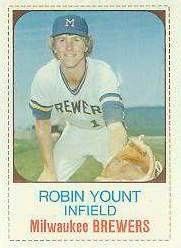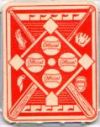1975 Hostess # 80 Robin Yount ROOKIE SHORT PRINT (Brewers)
One of Younts scarcest rookie cards !!!

Please wander around the website for more info, prices, values & images
on vintage baseball, football, basketball, hockey, sport and non-sports cards.


1951 Topps Red Backs |


1962 Post Cereal Baseball Checklist & Values
Similar to their 1961 set, the 1962 Post Cereal baseball cards were issued
on the backs of assorted boxes of Post Cereals, giving kids a fun
way to collect their favorite baseball players.
Click for complete
1962 Post Cereal Canadian baseball cards checklist & prices
I was a collector back then but for some reason I didn't pay much attention to the Post Cereal cards. I guess I loved my Maypo !!! Actually I loved my Farina with Nestle's Quick on top. But I degress... Wow !!! Mickey Mantle, Willie Mays, Hank Aaron, Roberto Clemente AND a box of cereal !!! How could you go wrong ??? 1962 Post was a very popular issue !!! Mickey Mantle and Roger Maris's HOME RUN dual (remember Maris hit 61 in 1961 !) was such a huge deal that cards of Mickey Mantle and Roger Maris were even issued as special inserts in LIFE Magazine. 1962 Post Cereal Canadian was a special version Post made for their Canadian collectors with the text in both French and English . The (2) versions are otherwise very similar and both the American and Canadian versions came in at (200) cards plus a bunch of variations. Click for complete 1961 Post Cereal baseball cards checklist & prices Click for complete 1963 Post Cereal baseball cards checklist & prices Click for complete 1962 Post Cereal baseball cards checklist & prices Note: You may be on that page right now. |

Starting approximately in 1886, sportscards, mostly baseball cards, were often included with tobacco products, for promotional purposes and also because the card reinforced the packaging and protected cigarettes from damage. These sports cards are referred to as tobacco cards in the baseball card hobby. Over the next few years many different companies produced baseball cards. Tobacco cards soon started to disappear as the American Tobacco Company tried to develop a monopoly by buying out other companies.
They were reintroduced in the 1900s, as American Tobacco came under pressure from antitrust action and Turkish competition. The most famous and most expensive, baseball card is the rare T206 Honus Wagner. The card exists in very limited quantities compared to others of its type because Wagner forced the card to be removed from printing. It is widely (and incorrectly) believed that Wagner did so because he refused to promote tobacco, but the true explanation lies in a dispute over compensation.
Soon other companies also began producing baseball and football cards. Sports magazines such as The Sporting News were early entries to the market. Candy manufacturers soon joined the fray and reflected a shift toward a younger target audience for cards. Caramel companies were particularly active and baseball cards were one of the first prizes to be included in Cracker Jacks. World War I soon suppressed baseball card production.
